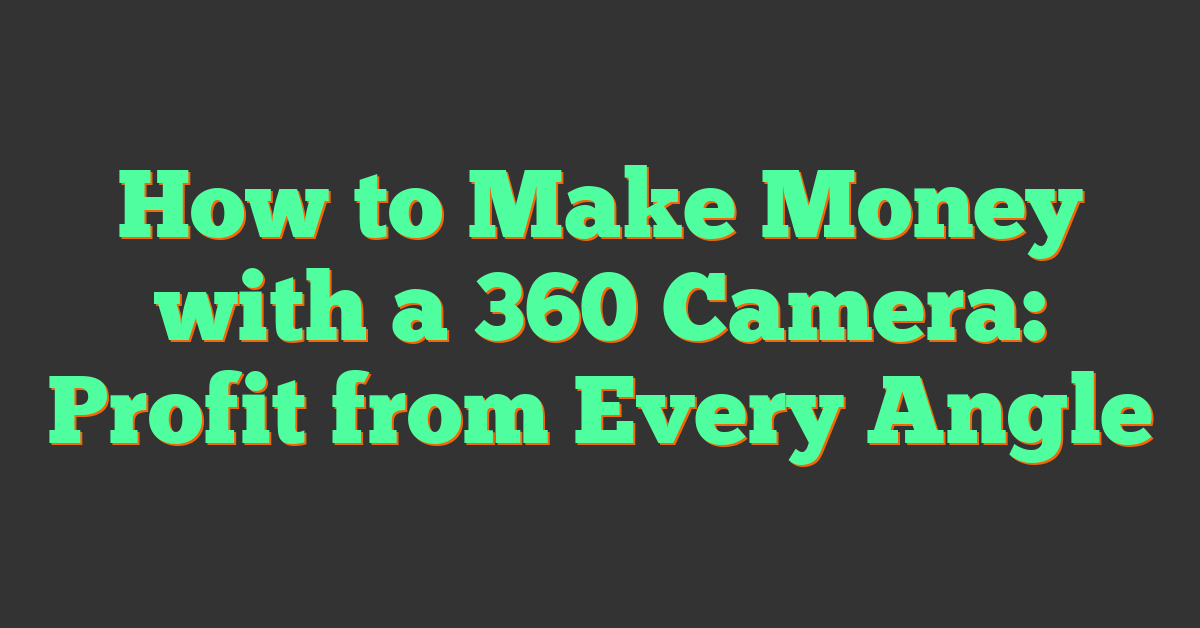With the advent of virtual reality and immersive content, 360 cameras have opened up new avenues for creators to earn income. Whether you’re a professional photographer, a hobbyist, or an entrepreneur looking for a new venture, these devices offer you the ability to capture breathtaking panoramic photos and videos. By creating 360-degree content, you can provide unique experiences that traditional cameras cannot, making it a potentially lucrative market niche.

The beauty of a 360 camera lies in its versatility. From virtual tours for real estate to interactive experiences for the hospitality industry, there are many ways for you to turn a 360-degree perspective into profit. The key is to understand the needs of your target market and how to effectively reach and serve them. With the right strategy and some creative ingenuity, your 360 camera can become more than just a gadget – it can be the foundation of a thriving business.
Key Takeaways
- 360 cameras present diverse opportunities to create unique, immersive content.
- Understanding your audience’s needs can lead to profitable 360-degree projects.
- Strategic marketing and innovation are essential for monetizing 360 content.
Understanding the 360 Camera Market

In entering the 360 camera market, your success hinges on discerning your specific target area within the niche, understanding the current demand, and knowing your competition.
Identifying Your Niche
Finding your niche in the world of 360-degree cameras means pinpointing where you can offer unique value. Whether your interest lies in creating VR experiences, enhancing AR apps, or supplying immersive real estate tours, your niche should align with your skills and market opportunities. Look into virtual tour services for sectors like real estate or consider developing interactive content for VR headsets to find your space within the market.
Evaluating Market Demand
Before you dive in, assess the demand in the market for 360 camera services. Interest in VR content is growing as tech becomes more accessible, suggesting a larger audience for immersive media. The 360-degree video content is pivotal for various industries, from tourism to online retail, indicating a robust sector waiting to be tapped by early adopters and innovative entrepreneurs.
Analyzing Competitors
Understanding who else is providing 360 camera services will help sharpen your business’s edge. Identify leading figures by searching who dominates the VR and AR camera scenes. For example, you might find that some are focusing on high-end VR content for commercial clients, while others may target real estate agents needing immersive tours. Recognize their strengths and gaps to determine how you could differentiate and position your offerings effectively in the market.
Setting Up Your 360 Camera Business
Embarking on your journey as a 360 camera entrepreneur involves careful planning and financial investment. Your strategic approach to this endeavor can lead to a profitable business.
Crafting a Business Plan
At the heart of launching your 360 camera business is your business plan. This document will be your roadmap, outlining your business strategy. You’ll need to determine your value proposition: what makes your services stand out? Next, identify your target market, which could include real estate agents interested in virtual tours or businesses looking for unique promotional material. Also, consider your marketing tactics: how will you reach and convince potential clients? Remember to be detailed; successful entrepreneurs know their plan inside and out.
Calculating Initial Investment
Your initial investment is more than just purchasing your 360 camera. Itemize each cost to understand the full price of starting up. Factor in your camera, of course, but also consider:
- Software: for stitching and editing footage
- Marketing: like website and business cards
- Transportation: getting to and from shooting locations
- Insurance: to protect your equipment and business
To start a small business, it’s crucial to be realistic and precise with your cost calculations to ensure the business remains profitable.
Creating a Strong Online Presence
To effectively monetize your 360 camera skills, establishing a robust online presence is essential. It bolsters your visibility and allows potential clients to discover your services with ease.
Building a Portfolio Website
Your portfolio website is your virtual storefront. Begin by selecting a domain name that reflects your brand and is easy to remember. Make sure to display a gallery of your best 360-degree images and videos to showcase your capabilities. This gallery should be easily accessible and neatly categorized to help visitors understand your range of work.
« Best Tripods for 360 Cameras: Top Picks for Stunning Panoramas
Best 360 Cameras for Google Street View: Top Picks for Capturing Panoramas »
Incorporate a blog to share your experiences, tips, and anything relevant to 360-degree content creation. This not only demonstrates your knowledge but also helps with SEO (Search Engine Optimization), increasing the chances of your site ranking on Google when potential clients search for related services.
Leveraging Social Media Platforms
Social Media is a powerful tool that can amplify your reach profoundly. Create profiles on major platforms like Facebook, YouTube, and Instagram, tailoring your content to each platform’s strengths (e.g., longer videos on YouTube, shorter clips and images on Instagram).
Use these social media platforms to engage with your audience through regular posts and interactive messaging. Be sure to incorporate a marketing strategy that includes consistent branding, targeted ads, and collaborations with influencers in your niche. This can expand your reach and help you connect with a broader audience that could require your 360 camera services.
Monetizing 360-Degree Content
With a 360 camera, you’ve unlocked a new dimension of revenue opportunities. By selling photos and videos or starting a virtual tour business, you can tap into markets eager for immersive content.
Selling Photos and Videos
Selling your 360-degree photos and videos can be a lucrative endeavor. Businesses often seek out high-quality, immersive content to boost their marketing efforts. You can sell these to:
- Stock image platforms
- Real estate agencies
- Travel websites
It’s essential to understand how to market your content effectively to interested buyers for maximum income. Premium, engaging content often garners the most attention and can help you build a steady stream of paying customers.
Starting a Virtual Tour Business
Virtual tours are especially popular in the real estate market. You could create virtual walk-throughs for real estate agents, helping them to sell homes quicker and for better prices. Your service provides an invaluable experience that photographs alone cannot.
As a virtual tour service provider, you cater to industries such as:
- Real estate
- Hotels and resorts
- Museums
To succeed, it’s imperative to understand your client’s needs and create virtual tours that enhance a business’s presence online. By providing this service, you create a new avenue for revenue, relying on both the novelty of the medium and the added value you bring to your clients’ businesses.
Navigating Legal and Financial Aspects

Before you start capitalizing on your 360 camera to earn money, it’s crucial to be aware of the legal and financial aspects. You’ll need a clear strategy for managing revenue, understanding copyright laws, and handling transactions, potentially through services like PayPal.
Understanding Copyright Laws
Copyright laws protect your creative works, so when you shoot with a 360 camera, you own the content. However, if your footage includes private property or copyrighted elements like music, you must obtain permission. To avoid legal issues, always ensure that:
- You have consent to shoot on private property.
- You secure licensing agreements for any third-party content.
Handling Transactions and Payments
When receiving payments for your virtual tours or other 360 content, maintaining a smooth transaction process is key. Here’s what you should consider:
- Use trusted services like PayPal for financial transactions to keep your money secure.
- Always provide itemized invoices to clients, detailing the services provided and the associated costs.
This approach will help you keep your finances in check, and your clients informed, contributing positively to your overall revenue growth.
Enhancing Content with Advanced Techniques
To truly leverage the potential of your 360 camera, you need to finesse your content with editing software and seamlessly blend in immersive spatial audio. Doing so will elevate the quality and experience for your audience.
Utilizing Editing Software
When you’re editing your 360-degree content, software becomes your best friend. Begin with selecting a capable editing suite that supports 360 video and has robust features for stitching multiple angles seamlessly. Stitching is crucial as it ensures that different camera feeds blend without noticeable seams, which might otherwise break the immersive experience. Programs like Adobe Premiere Pro or Final Cut Pro are popular choices that offer advanced tools for this. Additionally, look for fisheye lens correction features that counteract the distortions typical in 360 footage and improve the overall quality of your video.
Incorporating Spatial Audio
To provide a truly immersive experience, pair your video with spatial audio. This will give your content a 3D soundscape, making it feel as if the sound is coming from all directions. Recording with hardware specifically designed for spatial audio capture will give you a head start. Software such as Dolby Atmos or specialist tools within your audio editing program can then be harnessed to refine the spatial audio tracks, ensuring that the directionality and distance cues in your audio match the visuals. This coherence between what your audience sees and hears is paramount to maintaining the illusion of reality in 360-degree environments.
Targeting Real Estate Opportunities
In the competitive real estate market, leveraging a 360 camera can distinguish your services, especially in luxury listings to help sell property faster. Your expertise can appeal to real estate agents and property managers looking to increase occupancy through immersive visuals.
Collaborating with Real Estate Agents
Real estate agents are constantly on the lookout for innovative ways to showcase homes and garner greater interest. By providing detailed 360 virtual tours, you cater to agents who want to offer prospective buyers a thorough, interactive experience without the need for in-person visits. This service is particularly valuable for luxury listings, where highlighting the intricate details and overall ambiance of a property can be a game-changer in closing sales quickly.
Offering Services to Property Managers
As a property manager, especially in the apartment sector, your goal is to achieve high occupancy rates. By utilizing 360-degree tours, you offer potential tenants an in-depth view of the property, which can help fill vacancies more efficiently. These tours can be particularly persuasive, as they allow for a comprehensive preview of the space, which is a convenience that busy prospective tenants greatly appreciate.
Leveraging Emerging Technologies
Incorporating advanced technologies into your 360 camera ventures can open up lucrative opportunities. Embrace the virtual realm and integrate with new platforms to stay ahead in the competitive market.
Exploring VR and AR Applications
With your 360 camera, you can create content for Virtual Reality (VR) and Augmented Reality (AR). These immersive experiences can transport users to different places or overlay digital information in real-world settings. For instance, develop virtual tours that can be viewed with devices like Google Cardboard or higher-end VR headsets provided by companies like Microsoft. This content is not just engaging but can be monetized in sectors like real estate, tourism, and education.
Adapting to New Platforms
As new platforms emerge, being adaptable is key. Stay current by uploading your 360 content to platforms that support VR and AR experiences. Make sure you’re familiar with different content management systems that suit these formats. By doing so, you can reach a broader audience and find new revenue streams, ensuring your content remains accessible and profitable as technology evolves.
Expanding Your Service Offerings
When you’re looking to grow your 360 camera business, expanding the services you offer can play a crucial role. Finding new ways to leverage your camera not only boosts your potential revenue but also increases your value to your clients.
Developing Virtual Tours for Various Sectors
Creating virtual tours is a fantastic strategy to tap into different markets. Whether for real estate, education, or tourism, your virtual tour company can address the specific needs of each sector with a targeted approach. For instance:
- Real Estate: Offer immersive experiences to potential homebuyers who want to explore properties remotely.
- Education: Help schools and universities showcase their campuses to prospective students globally.
- Tourism: Collaborate with local attractions to create tours that entice visitors and boost marketing efforts.
Private Labeling and Brand Partnerships
Expanding into private labeling and forging brand partnerships can propel your business into new realms. Here’s how you could approach it:
- Local Businesses: Partner with local service providers and retailers to create branded content that features their products uniquely.
- Marketing Campaigns: Work with marketing strategists to incorporate immersive 360 content for campaigns that stand out.
By aligning your services with recognized brands, you not only gain exposure but also establish your reputation as a premium service provider.
Effective Pricing and Sales Strategies
To make the most of your 360 camera business, finding the right price point and offering attractive packages to your clients are essential. These strategies not only help in establishing the value of your services but also ensure that you meet your business goals and cater to client expectations effectively.
Determining Your Price Point
Start by evaluating the costs of your operation and adding a margin for profit to arrive at a base price. This should cover the expenses and the time you’ve invested in using your 360-degree camera setup. Then, research the market to understand what your competitors are charging. You don’t want to undersell your skills, nor do you want to set the bar so high that clients are turned away. An effective pricing strategy takes into account your business model’s simplicity, the unique value you provide, and how it stands out in the marketplace.
Creating Attractive Packages for Clients
Once you’ve determined your price point, package your services to offer clear value for your clients. Bundling your services can be more attractive than a per-item pricing approach. For example, offer a basic package that covers essentials, a premium package with additional features like extra editing or virtual tour creation, and perhaps a custom package to cater to unique client needs. Align these packages with your clients’ goals, such as marketing or real estate showcasing, to ensure they feel they’re getting the best deal for their specific requirements. Your sales strategy must highlight the innovative capabilities of 360-degree cameras, such as virtual reality experiences, which provide substantial value and can justify a higher pricing tier for those services.
By adopting a friendly and approachable manner, your pricing and sales strategies will not only resonate with your clients but also reinforce the sustainable growth of your 360 camera business.
Growing and Scaling Your Business
To transform your venture with a 360 camera from a side gig to a substantial income stream requires strategic planning in client acquisition and developing an effective, scalable workflow.
Increasing Client Base
Your ability to attract more clients hinges on deploying a savvy marketing strategy. A starting point could be leveraging platforms which detail how to acquire your first 30 customers, since these first clients are crucial to boost your business’s credibility. Remember to:
- Utilize social media: Showcase your portfolio to increase leads.
- Network: Attend events and connect with potential clients in your niche.
- Ask for referrals: Encourage satisfied clients to refer others.
Building a Scalable Workflow
For your business to handle increased workload without a hitch, it’s essential to develop a scalable workflow. This means establishing systems that maximize efficiency and maintain quality as you scale and grow. Consider:
- Automating repetitive tasks: This reduces time spent and helps manage more projects simultaneously.
- Outsourcing: Delegate routine editing work freeing up time for income-generating activities.
By focusing on these strategies, you’ll pave the way from being a struggling newbie to a successful entrepreneur in the 360 camera business landscape.
Frequently Asked Questions

Explore ways to leverage your 360-degree camera and dive into the world of immersive photography to boost your income.
What are some effective ways to monetize 360-degree photography for real estate?
You can create interactive virtual tours for property listings, offering clients a better sense of space. Offering add-on services, such as aerial shots or day-to-night edits, can also enhance your service’s value.
Can you create profitable virtual tours using just a smartphone?
While smartphones can capture 360-degree content, professional-grade cameras provide higher quality images crucial for creating profitable virtual tours that truly stand out.
What are the best platforms for selling 360-degree photos?
Look into stock photo websites tailored to 360-degree content or marketplaces for virtual reality assets. Also, consider setting up a personal website to showcase and sell your work directly to clients.
What are the costs associated with starting a 360-degree photography business?
Initial costs often include the camera itself, editing software, and potentially a subscription to a virtual tour hosting platform. Don’t forget to account for marketing and transportation expenses as well.
How can you generate income from creating Matterport virtual tours?
You can offer Matterport virtual tours as a premium service to real estate agents, architects, and retailers, utilizing the platform’s powerful tools to deliver immersive experiences that clients are willing to pay a premium for.
In what industries, besides real estate, is 360-degree photography in demand?
Tourism, event planning, and retail are just a few sectors where 360-degree photography is growing in popularity. These industries value immersive visual experiences for marketing and online engagement.










